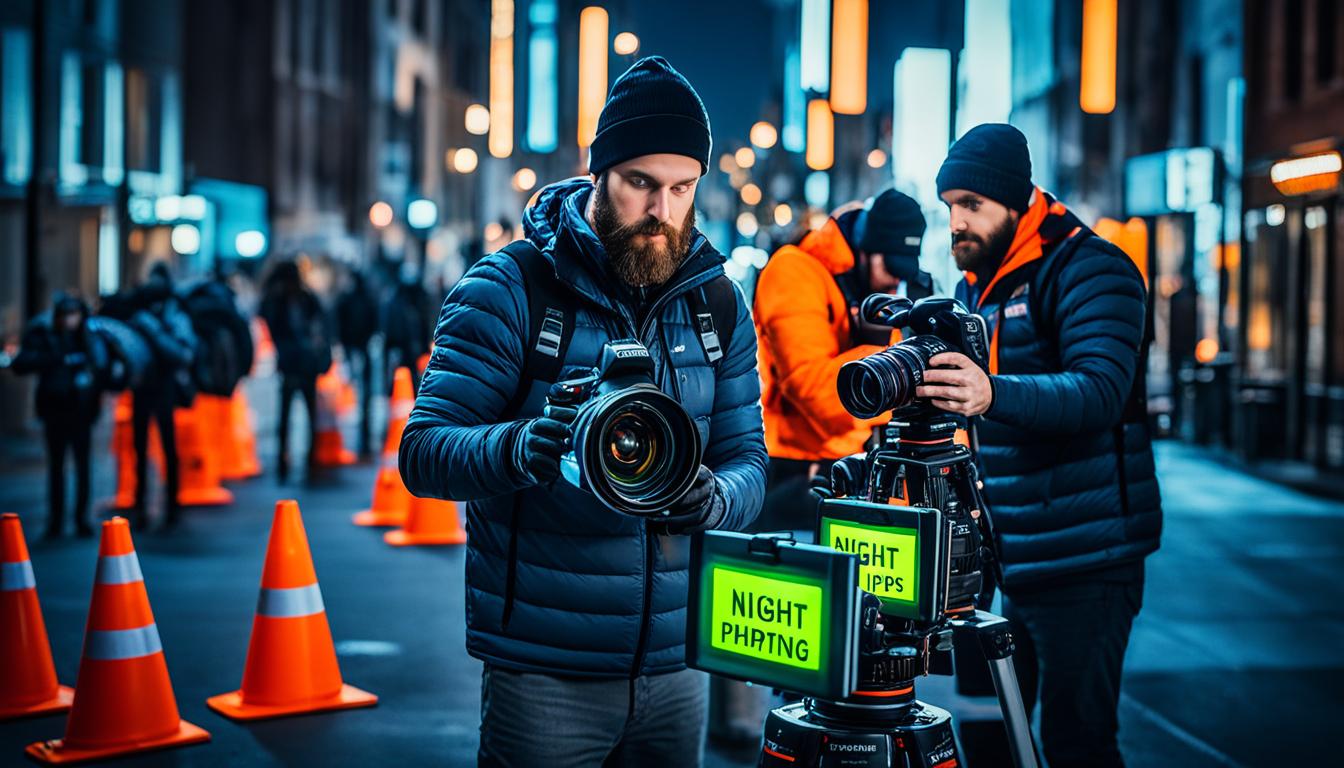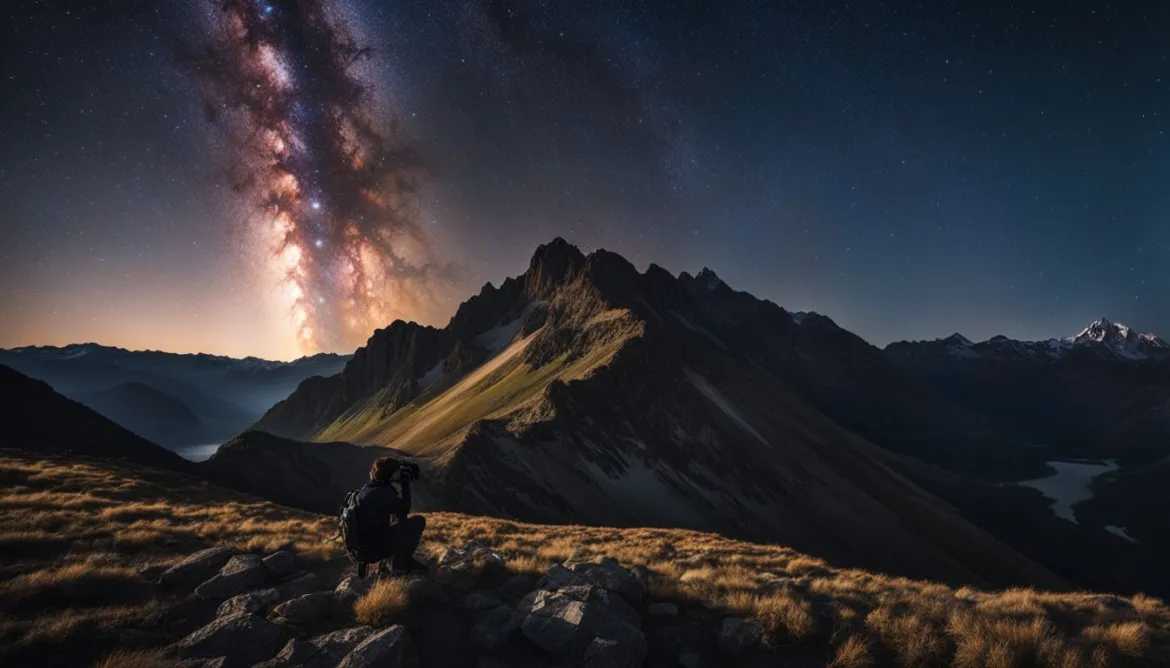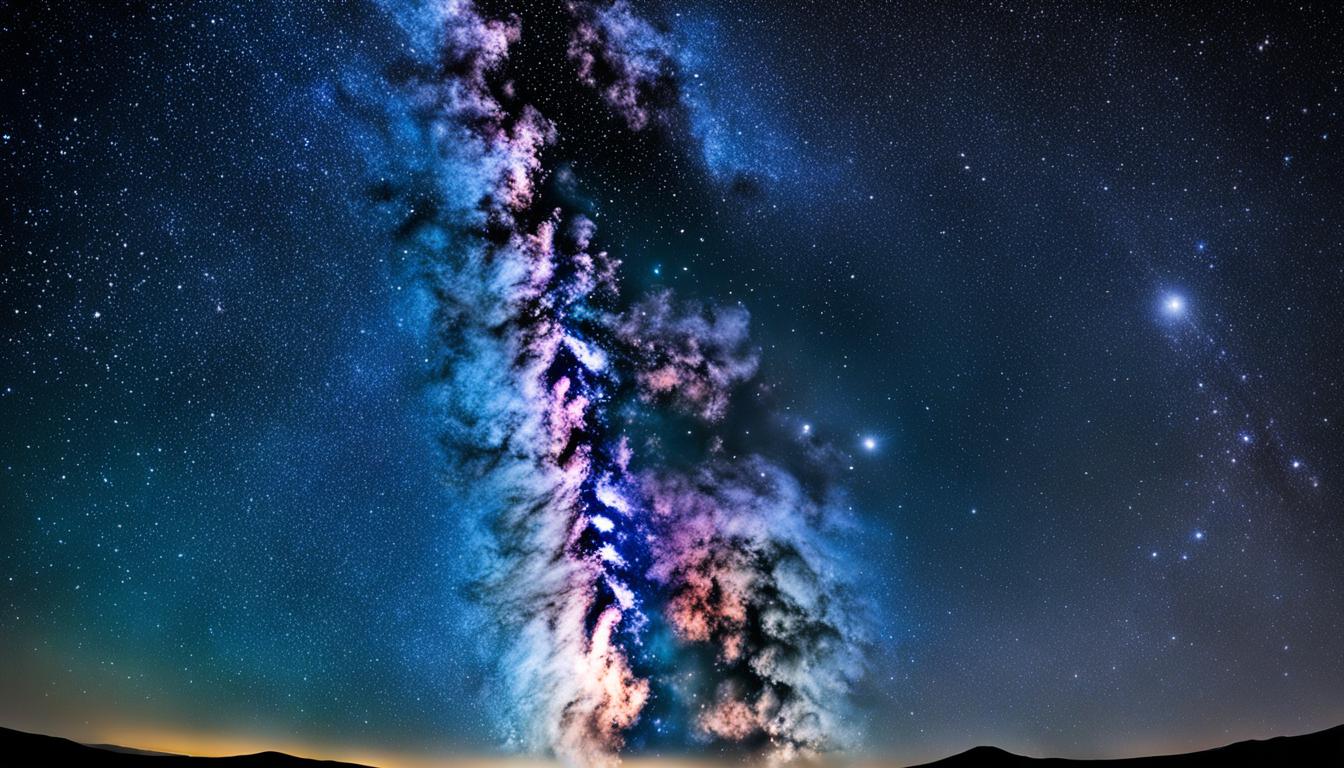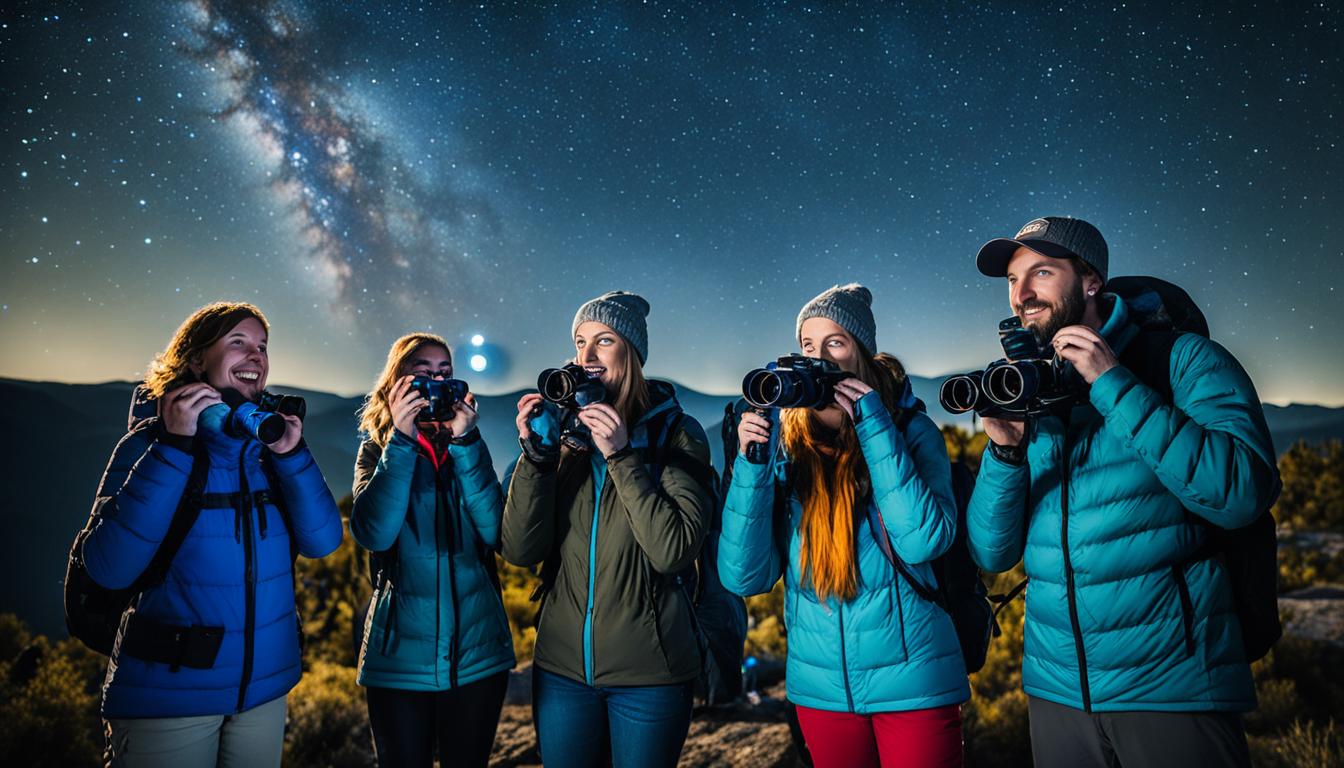Night photography provides a unique and exhilarating experience for photographers. The opportunity to capture stunning images in low light conditions can result in breathtaking pictures. However, it is important to remember that safety and etiquette should always be prioritized to ensure a smooth and respectful night photography session.
By following some key tips and guidelines, we can navigate the challenges of nighttime shooting while respecting our surroundings and minimizing potential risks. Let’s explore safety measures and etiquette guidelines for nighttime photography.
Key Takeaways:
- Always prioritize safety when engaging in night photography
- Respect your surroundings and minimize disruptions to others
- Be aware of your environment and ensure personal safety
- Utilize proper gear and equipment for optimal results
- Practice responsible etiquette when photographing people or private property
Embracing Darkness: Tips for Night Street Photography
In night street photography, darkness transforms urban landscapes into captivating and mysterious scenes. As photographers, we have the opportunity to capture these unique moments and create compelling images that evoke a sense of wonder and intrigue. To make the most of your nighttime photo shoot, it’s important to follow some best practices and take the necessary safety precautions while respecting your surroundings.
One of the key techniques in night street photography is embracing shadows and creating silhouettes. By using the interplay of light and dark, you can add depth and drama to your images. Look for interesting light sources like street lamps or neon signs that cast intriguing shadows. By positioning your subject against these sources of light, you can create striking silhouettes that tell a story.
Observing the play of light and shadow is essential in capturing the mood and atmosphere of the night. Pay attention to the contrast between bright areas and deep shadows, as well as the patterns and shapes that emerge in low light conditions. Use these elements to add visual interest and create compositions that engage the viewer.
While exploring the streets at night, it’s crucial to prioritize safety. Be aware of your surroundings and keep an eye out for any potential hazards. Stick to well-lit areas and avoid secluded or unfamiliar locations. Additionally, always let someone know where you’ll be and consider shooting in a group for added security.
Respecting the environment is equally important. Be mindful of your impact on public spaces and private property. Avoid trespassing and be considerate of noise levels and disturbance to residents. By practicing nighttime photography with respect for your surroundings, you can foster a positive relationship between photographers and the communities they capture.
“Night street photography allows us to embrace the darkness, unlocking the beauty and mystery hidden within. By understanding the technical aspects and respecting our surroundings, we can capture the essence of the night and create images that evoke a sense of wonder and intrigue.”
Essential Camera Settings for Night Photography
When it comes to nighttime photography, mastering your camera settings is essential for capturing breathtaking images in low light conditions. By understanding the key settings and techniques, you can ensure well-exposed photos while prioritizing safety and following proper photography etiquette.
Wide Apertures for Capturing Light
One of the fundamental camera settings to consider for night photography is using a wide aperture. By opening up your lens to its maximum aperture, you allow more light to enter, resulting in brighter and more detailed images. This is especially important when shooting in dark environments where natural light is scarce.
Slower Shutter Speeds to Avoid Motion Blur
Another crucial camera setting for nighttime photography is utilizing slower shutter speeds. With longer exposures, you can capture the ambient light and create mesmerizing light trails or starry skies. However, be mindful of potential motion blur, especially when photographing handheld. To mitigate this, consider using a tripod or stabilizing your camera to ensure sharp and crisp images.
Higher ISO Settings for Night Ambiance
Increasing the ISO setting allows your camera to be more sensitive to light, making it an essential tool for night photography. However, keep in mind that higher ISO values can introduce digital noise to your images. To counter this, you can use noise reduction techniques during post-processing or select cameras that handle high ISO well. Additionally, adjusting the exposure compensation to a negative value can enhance the night ambiance and prevent overexposure.
Manual Mode for Greater Control
Using the manual mode in your camera provides greater control over exposure settings, ensuring that your photos accurately represent the scene’s lighting conditions. By adjusting the ISO, aperture, and shutter speed individually, you can fine-tune the exposure according to your creative vision. To maintain flexibility while shooting, consider pairing manual mode with auto ISO to allow the camera to adjust the sensitivity to changing lighting conditions.
Remember, understanding how to balance ISO, aperture, and shutter speed is vital for achieving well-exposed images in low light conditions.
By implementing these essential camera settings for night photography, you’ll be equipped to capture stunning images after dark while adhering to late night photo session safety rules and respecting darkness photography safety measures.

Gear Recommendations for Night Street Photography
Choosing the right gear is crucial for successful night street photography. To capture stunning images in low light environments, it’s essential to consider cameras that handle high ISO well and lenses with wide apertures. Additionally, opting for compact and lightweight camera bodies with large sensors will provide optimal low-light performance.
“Having the right gear is like having a partner that understands your creative vision in the dark”
We recommend investing in high-quality equipment from reputable brands such as Nikon, Canon, Sony, and Fujifilm. These brands offer a wide range of options specifically designed for low-light photography. For cameras, consider models like the Nikon D850, Canon EOS R6, Sony Alpha A7 III, and Fujifilm X-T4. These cameras feature excellent ISO performance, advanced autofocus systems, and impressive dynamic range.
In terms of lenses, prime lenses with wide apertures are highly recommended for night street photography. These lenses allow more light to enter the camera, resulting in brighter and sharper images. Popular options include the Nikon AF-S Nikkor 35mm f/1.8G, Canon RF 50mm f/1.2L USM, Sony FE 35mm f/1.8, and Fujifilm XF 23mm f/1.4 R.
“The right gear elevates your night photography to new dimensions, capturing the beauty and ambiance of the night with precision”
Accessories such as tripods and flashes can also enhance your night street photography experience. Tripods provide stability, allowing for longer exposures without camera shake. Look for lightweight and durable tripods like the Manfrotto Befree Advanced Carbon Fiber or the Gitzo GT1545T Traveler. Flashes can be used creatively to add interesting lighting effects or fill in shadows. The Nikon SB-5000, Canon Speedlite 600EX II-RT, Sony HVL-F60RM, and Fujifilm EF-60 are popular choices.
“Accessories like tripods and flashes are the secret ingredients to taking your night street photography to the next level”
In addition, it’s important to choose inconspicuous gear to blend in with your surroundings. This helps to avoid drawing unwanted attention and maintain a low-profile presence. Consider using camera bags and straps that don’t reveal expensive equipment and attract unnecessary attention.
“Inconspicuous gear is the stealth mode that allows you to become one with the night streets, capturing soulful images unnoticed”
Furthermore, for added safety and security, it’s wise to have a secondary camera body as a backup. This ensures that you can continue shooting even if a technical issue arises with your primary camera body.
“Having a backup camera body is like having a guardian angel ensuring you never miss the perfect shot”
| Camera | Lens |
|---|---|
| Nikon D850 | Nikon AF-S Nikkor 35mm f/1.8G |
| Canon EOS R6 | Canon RF 50mm f/1.2L USM |
| Sony Alpha A7 III | Sony FE 35mm f/1.8 |
| Fujifilm X-T4 | Fujifilm XF 23mm f/1.4 R |
Scouting Locations and Subjects for Night Street Photography
Before embarking on a thrilling night street photography session, we need to scout suitable locations and seek out interesting subjects and scenes to capture. By carefully choosing our surroundings, we can set the stage for visually compelling and captivating nighttime images.
When scouting for locations, keep an eye out for areas with distinctive lighting, such as neon signs or street lamps. These sources of light add depth and character to our images, creating an atmospheric and intriguing ambiance. The interplay between light and shadows can evoke a sense of mystery and drama in our compositions.
In addition to lighting, we can find inspiration in ordinary objects by seeking out contrasts, patterns, and hidden beauty. Look for interesting textures, vibrant colors, or unique shapes that stand out in the darkness. By capturing these details, we can add depth and visual interest to our photographs.
Composition is key in night street photography, and there are a few techniques that can help us create visually stunning images. One powerful composition technique is the rule of thirds, which involves placing the main subjects or points of interest off-center, intersecting with imaginary lines that divide the frame into thirds. This technique adds balance and visual interest to our photos, making them more appealing to the viewer’s eye.
Another technique to consider is utilizing leading lines to guide the viewer’s gaze through the image. Look for natural or architectural elements like roads, walkways, or buildings that form lines leading towards the main subject. Leading lines can create a sense of depth and draw attention to the focal point of our composition.
As important as capturing stunning images is, we must always prioritize safety and respect the privacy of others while shooting at night. Be mindful of your surroundings, stay aware of your surroundings, and avoid putting yourself or others in potentially dangerous situations. Remember, capturing the unique atmosphere of a city at night is a privilege that comes with responsibility.
Let’s take a moment to appreciate the beauty and intrigue of nighttime photography as we explore the urban landscape in search of hidden gems.

Conclusion
Capturing nighttime images can be an exciting and rewarding experience for photographers. To ensure a safe and respectful late-night photo session, it is essential to prioritize safety measures and respect for your surroundings. By following the right safety rules and maintaining proper etiquette, you can navigate the challenges of darkness photography while creating stunning and respectful images.
To begin, make sure you are well-prepared by mastering essential camera settings and choosing appropriate gear for nighttime shooting. Understanding how to adjust your camera’s aperture, shutter speed, and ISO settings is crucial for capturing well-exposed images in low light conditions. Additionally, investing in gear that handles high ISO well and opting for lenses with wide apertures will help you capture the necessary light in dark environments.
Another important aspect of nighttime photography is scouting locations and subjects. Before embarking on your late-night photo session, take the time to identify interesting scenes and objects that will enhance your compositions. Look for areas with distinctive lighting, contrasting elements, and patterns that will add depth and character to your images. Remember to respect the privacy of others and be mindful of your surroundings while looking for unique subjects.
As you venture out into the night, always prioritize your personal safety. Be aware of your surroundings and ensure you are adhering to any specific safety rules or regulations of the location you are photographing. It’s important to stay vigilant and alert to avoid potential risks. By following these safety measures and respecting your surroundings, you can enjoy the process of capturing the magic of night photography while ensuring a positive and enjoyable experience for yourself and others.
FAQ
What are some safety tips for nighttime photography?
When shooting at night, always prioritize your safety. Be aware of your surroundings, especially in unfamiliar or dimly lit areas. Carry a flashlight and keep it within reach. If shooting in a crowded area, be cautious of potential trip hazards caused by equipment or cables. Avoid putting yourself in risky situations and trust your instincts if something feels unsafe.
How can I respect my surroundings while shooting at night?
It’s important to be respectful of your environment and the people around you while photographing at night. Avoid disturbing the peace by minimizing noise and flash usage. Respect private property and laws regarding photography permits in certain locations. Be mindful of others’ privacy and seek permission when photographing individuals or their property.
What are some best practices for nighttime photo shoots?
When planning a nighttime photo shoot, it’s important to be prepared. Check the weather forecast and dress appropriately for the conditions. Bring extra batteries and memory cards to avoid interruptions. Familiarize yourself with the location beforehand to ensure you have a clear idea of the shots you want to capture. Additionally, inform someone of your location and estimated return time for added safety.
What camera settings should I use for night photography?
To capture well-exposed images in low light conditions, consider using a wide aperture to allow more light into your camera sensor. Use slower shutter speeds to avoid motion blur, but keep in mind that a tripod may be necessary to prevent camera shake. Adjust your ISO settings accordingly, aiming for a higher ISO with negative exposure compensation to enhance the night ambiance. Experiment with manual mode to have greater control over your exposure.
What gear is recommended for night street photography?
When shooting at night, opt for cameras with excellent low-light performance and lenses with wide apertures to capture sufficient light. Compact and lightweight camera bodies with large sensors are ideal for low-light conditions. Consider using accessories such as tripods to stabilize your camera and flashes for creative lighting effects. It’s also advisable to carry inconspicuous gear to avoid unnecessary attention and have a secondary camera body for added security.
How should I find interesting locations and subjects for night street photography?
Before embarking on your night street photography session, scout locations during the daytime and observe which areas have distinctive lighting or interesting architectural details. Look for neon signs, street lamps, or areas with contrasting light sources. Seek out unique patterns, textures, and shapes that can be highlighted in your images. Pay attention to leading lines and the rule of thirds to create visually appealing compositions.
Can Following Tips for Conquering Light Pollution Help with Night Photography Safety and Etiquette?
When practicing night photography in urban areas, using the right tips for city star shooters can make a world of difference. By following these helpful guidelines, photographers can minimize light pollution, ensuring a safer and more respectful experience for both themselves and others enjoying the night sky.




